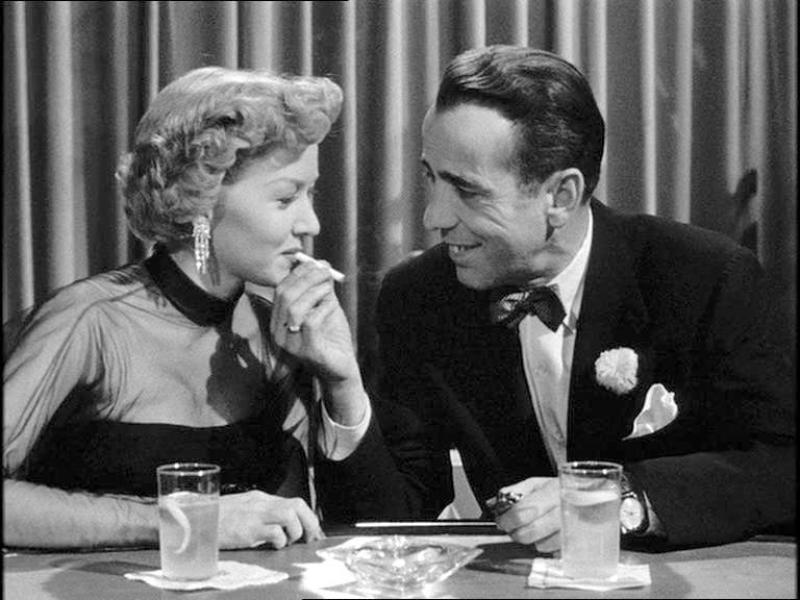DVD: In a Lonely Place | reviews, news & interviews
DVD: In a Lonely Place
DVD: In a Lonely Place
Nicholas Ray's masterful thriller ponders the screenwriter's art and impossible love

In a Lonely Place (1950) contains one of the most harrowing night-time drives in all of film noir. Dix Steele (Humphrey Bogart), a volatile screenwriter suspected of murder, accidentally learns that his new girlfriend, Laurel Gray (Gloria Grahame), has been freshly interviewed by detectives. In one of his uncontrollable rages, Dix slaloms through the Hollywood hills, the terrified Laurel in the passenger seat, and scrapes the paint off another car.
Nicholas Ray’s romantic thriller is only a noir by common consent, however. Ray used the genre’s format as a conduit for exploring two torturous processes dependent on evasion and concealment: the distillation of a classy screenplay from a trashy source, which Dix explicates to Laurel and his friends as he writes one, and the curdling of a passionate affair that was bringing about redemption.
Even as they made the film with maximum professionalism in the fall of 1949, Ray and Grahame’s marriage was undergoing its first collapse. A master of psychological realism, Ray bequeathed Dix his own paranoia and Bogart’s brawler image while drawing on Grahame’s elusiveness – apparently real – to ramp up Laurel’s ambiguity. She gave one of her greatest performances.
It isn’t all hell. The clearly post-coital intimacy demonstrated by Dix and Laurel as they smoke and drink cocktails at the end of nightclub performer Hadda Brooks's piano was uncommonly adult for a Hollywood film. Laurel’s attempt to build a surrogate family around Dix with the help of his sweet old agent (Art Smith) and a washed-up, Shakespeare-spouting ham actor (Robert Warwick) is deeply moving. But there’s no brooking Dix’s existential choices – which augured Ray’s own eventual alienation from the studio system.
Among the features on the Criterion Collection’s Blu-ray edition are a revealing video essay on Grahame by her biographer Vincent Curcio, a shortened version of the 1975 Ray documentary I’m a Stranger Here Myself, and a radio adaptation of Dorothy B. Hughes’ source novel – the ultra-bleak ending of which Ray felt obliged to eliminate from the movie.
rating
Share this article
The future of Arts Journalism
You can stop theartsdesk.com closing!
We urgently need financing to survive. Our fundraising drive has thus far raised £49,000 but we need to reach £100,000 or we will be forced to close. Please contribute here: https://gofund.me/c3f6033d
And if you can forward this information to anyone who might assist, we’d be grateful.

Subscribe to theartsdesk.com
Thank you for continuing to read our work on theartsdesk.com. For unlimited access to every article in its entirety, including our archive of more than 15,000 pieces, we're asking for £5 per month or £40 per year. We feel it's a very good deal, and hope you do too.
To take a subscription now simply click here.
And if you're looking for that extra gift for a friend or family member, why not treat them to a theartsdesk.com gift subscription?
more Film
 Blu-ray: The Graduate
Post #MeToo, can Mike Nichols' second feature still lay claim to Classic Film status?
Blu-ray: The Graduate
Post #MeToo, can Mike Nichols' second feature still lay claim to Classic Film status?
 Little Trouble Girls review - masterful debut breathes new life into a girl's sexual awakening
Urska Dukic's study of a confused Catholic teenager is exquisitely realised
Little Trouble Girls review - masterful debut breathes new life into a girl's sexual awakening
Urska Dukic's study of a confused Catholic teenager is exquisitely realised
 Young Mothers review - the Dardennes explore teenage motherhood in compelling drama
Life after birth: five young mothers in Liège struggle to provide for their babies
Young Mothers review - the Dardennes explore teenage motherhood in compelling drama
Life after birth: five young mothers in Liège struggle to provide for their babies
 Blu-ray: Finis Terrae
Bleak but compelling semi-documentary, filmed on location in Brittany
Blu-ray: Finis Terrae
Bleak but compelling semi-documentary, filmed on location in Brittany
 Oslo Stories Trilogy: Sex review - sexual identity slips, hurts and heals
A quietly visionary series concludes with two chimney sweeps' awkward sexual liberation
Oslo Stories Trilogy: Sex review - sexual identity slips, hurts and heals
A quietly visionary series concludes with two chimney sweeps' awkward sexual liberation
 Sorry, Baby review - the healing power of friendship in the aftermath of sexual assault
Eva Victor writes, directs and stars in their endearing debut feature
Sorry, Baby review - the healing power of friendship in the aftermath of sexual assault
Eva Victor writes, directs and stars in their endearing debut feature
 Blu-ray: Who Wants to Kill Jessie?
Fast-paced and visually inventive Czech comedy
Blu-ray: Who Wants to Kill Jessie?
Fast-paced and visually inventive Czech comedy
 Oslo Stories Trilogy: Love review - freed love
Gay cruising offers straight female lessons in a heady ode to urban connection
Oslo Stories Trilogy: Love review - freed love
Gay cruising offers straight female lessons in a heady ode to urban connection
 Beating Hearts review - kiss kiss, slam slam
Romance and clobberings in a so-so French melodrama
Beating Hearts review - kiss kiss, slam slam
Romance and clobberings in a so-so French melodrama
 Materialists review - a misfiring romcom or an undercooked satire?
Writer-director Celine Song's latest can't decide what kind of film it is
Materialists review - a misfiring romcom or an undercooked satire?
Writer-director Celine Song's latest can't decide what kind of film it is
 theartsdesk Q&A: actor Leonie Benesch on playing an overburdened nurse in the Swiss drama 'Late Shift'
The Guildhall-trained German star talks about the enormous pressures placed on nurses and her admiration for British films and TV
theartsdesk Q&A: actor Leonie Benesch on playing an overburdened nurse in the Swiss drama 'Late Shift'
The Guildhall-trained German star talks about the enormous pressures placed on nurses and her admiration for British films and TV

Add comment